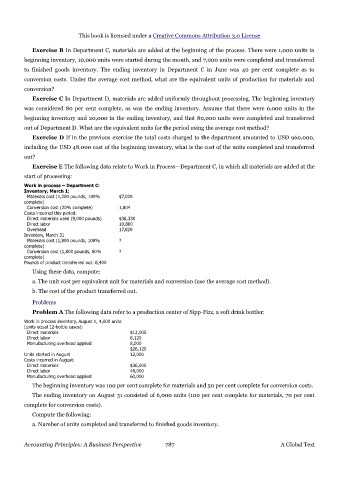Page 786 - Accounting Principles (A Business Perspective)
P. 786
This book is licensed under a Creative Commons Attribution 3.0 License
Exercise B In Department C, materials are added at the beginning of the process. There were 1,000 units in
beginning inventory, 10,000 units were started during the month, and 7,000 units were completed and transferred
to finished goods inventory. The ending inventory in Department C in June was 40 per cent complete as to
conversion costs. Under the average cost method, what are the equivalent units of production for materials and
conversion?
Exercise C In Department D, materials are added uniformly throughout processing. The beginning inventory
was considered 80 per cent complete, as was the ending inventory. Assume that there were 6,000 units in the
beginning inventory and 20,000 in the ending inventory, and that 80,000 units were completed and transferred
out of Department D. What are the equivalent units for the period using the average cost method?
Exercise D If in the previous exercise the total costs charged to the department amounted to USD 960,000,
including the USD 48,000 cost of the beginning inventory, what is the cost of the units completed and transferred
out?
Exercise E The following data relate to Work in Process—Department C, in which all materials are added at the
start of processing:
Work in process – Department C:
Inventory, March 1:
Materials cost (1,200 pounds; 100% $7,020
complete)
Conversion cost (20% complete) 1,804
Costs incurred this period:
Direct materials used (9,000 pounds) $36,330
Direct labor 10,880
Overhead 17,820
Inventory, March 31
Materials cost (1,800 pounds, 100% ?
complete)
Conversion cost (1,800 pounds, 80% ?
complete)
Pounds of product transferred out: 8,400
Using these data, compute:
a. The unit cost per equivalent unit for materials and conversion (use the average cost method).
b. The cost of the product transferred out.
Problems
Problem A The following data refer to a production center of Sipp-Fizz, a soft drink bottler:
Work in process inventory, August 1, 4,000 units
(units equal 12-bottle cases):
Direct materials $12,000
Direct labor 6,120
Manufacturing overhead applied 8,000
$26,120
Units started in August 12,000
Costs incurred in August:
Direct materials $36,000
Direct labor 48,000
Manufacturing overhead applied 60,000
The beginning inventory was 100 per cent complete for materials and 50 per cent complete for conversion costs.
The ending inventory on August 31 consisted of 6,000 units (100 per cent complete for materials, 70 per cent
complete for conversion costs).
Compute the following:
a. Number of units completed and transferred to finished goods inventory.
Accounting Principles: A Business Perspective 787 A Global Text

